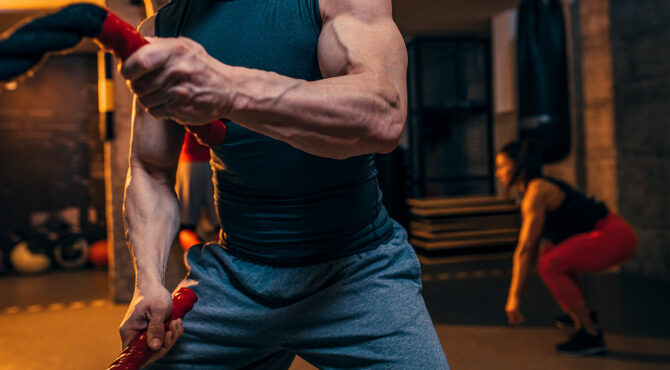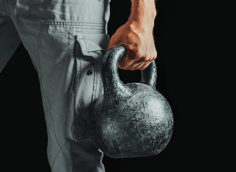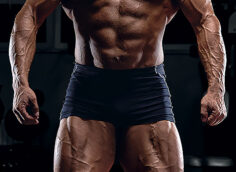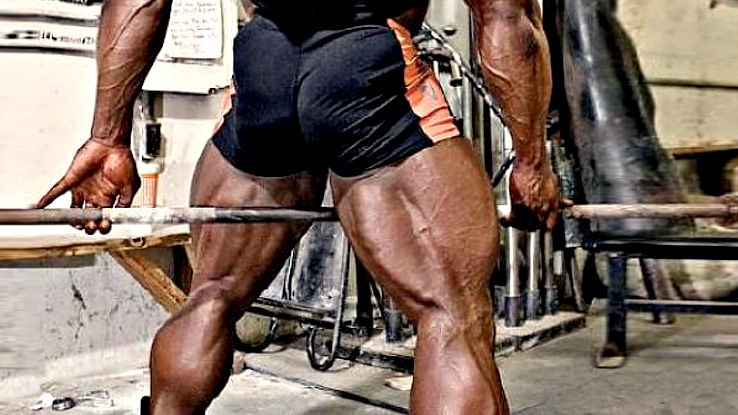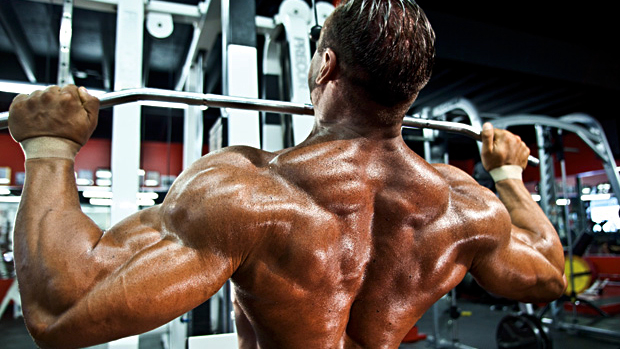Strength AND Conditioning?
If you want to get big and strong, are you doomed to a life of getting winded when you walk up a flight of stairs, or worse, dying young of a heart issue? Is there a way to get big, strong, AND fit? Yes. Do concurrent training.
Recently, Sports Medicine published a systematic review and meta-analysis on concurrent training (3). As a refresher, concurrent training is when you train for two different goals simultaneously. In this case, getting jacked along with improving conditioning.
The meta-analysis examined 43 different studies comparing concurrent training (strength training and cardio) to the same strength program but with no cardio. The results showed no differences in strength and hypertrophy. However, explosive strength was hurt when combining resistance training and cardio in the same workout compared to separating those workouts by at least 3 hours.
Let's break that down, then look at three ways to combine conditioning with your strength and hypertrophy goals successfully.
Never fall into the trap of saying, "Science says it, so that settles it!" Science just shows you trends and averages. It gives you clues as to what might work for you, saving you trial and error time. Concurrent training studies are relatively short, and few use advanced lifters. This leaves us with a big unanswered question: How will this play out for advanced trainees in the long term? Here's what you need to consider:
1. Specificity
Conditioning adaptations don't just take place in your heart and lungs; they also take place in your muscles. If you want to be a great runner, you have to run. But if you just want to be in decent all-around shape, you have options.
You also want to consider what your body has to do to adapt to the stress. For example, when you stress your body with countless miles of running, your body loses muscle (which is deadweight for a runner). However, sprinting and loaded carries like farmer's walks force your body to hold on to muscle because it needs muscle to survive these stressors.
2. Training Level
This study grouped participants into "untrained" and "active." While the study didn't find differences based on training level, it's unlikely that any of the participants were what we'd call "advanced." Another meta-analysis found that adding endurance training had a negative impact on strength in trained lifters but not in untrained or moderately-trained lifters (1).
Beginners can do almost anything and get better at almost everything. As you move past the beginner level, you have to make choices.
3. Genetics
Work ethic is huge, but you can't ignore genetics. Whenever someone points to examples of NFL players and other athletes who are big, strong, lean, fast, and have amazing conditioning, they're looking at the genetic super-elite. These athletes have mesomorph body types that are naturally strong and muscular. They are high responders to training. Training and recovery is their full-time job, and some may even be using chemical assistance.
All of these factors allow them to gain optimal size and strength faster, so they can devote more resources to conditioning. If you're a naturally scrawny ectomorph who wants to optimize your muscle-building potential, you'll have to devote the large majority of your resources to this goal.
4. Ultimate Goal
The further you want to push one fitness quality, the more you have to make sacrifices in other areas. If you want to be the best in the world at something, you're going to have to suck at almost everything else.
Look, no team-sport athlete has the strength of an elite powerlifter, the speed of an Olympic sprinter, the muscle mass of a pro bodybuilder, and the aerobic capacity of a top marathon runner. They aren't even close to the best in the world at any one fitness quality. Instead, these athletes seek the optimal compromise of each important fitness quality. Then they focus on becoming the best they can be at the skills and tactics of their chosen sport.
There's a good chance you'll never win an Olympic gold medal. Instead, seek the optimal compromise of strength, speed, muscle mass, and conditioning that's right for you.
- It's okay to have a basic level of cardiovascular fitness with high levels of strength and hypertrophy.
- It's okay to have a moderate level of strength and high-performance cardio.
- It's okay to be good, but not great, at both strength and cardio.
Be reasonable with your expectations. Be wise and efficient with your training.

1. Walking
Pros: Amazing for physical health, mental health, and recovery. It will have the least interference with lifting.
Cons: You won't see fitness improvements from walking unless you're really out of shape.
Tip: Quick 10-minute walks after your three big meals of the day are better for cardiometabolic health than one 30-minute walk per day (4).
2. Steady-State Cardio
Pros: Offers great health and fitness benefits.
Cons: Could interfere with strength and hypertrophy if you do too much. Some forms, like jogging, also place a lot of stress on your joints.
Tip: It's best for those who love it or need it specifically for their goals.
3. HIIT
Pros: High-intensity interval training is the most time-efficient way to get into great shape. It doesn't interfere with muscle mass or upper-body strength (2), but it might interfere with lower-body strength (cycling more so than running).
Cons: HIIT is very intense.
Tips:
- Have a base of conditioning and strength before doing HIIT.
- Consider the joint stress of each exercise option, especially when you're also lifting.
- Because HIIT is so intense, use it sparingly.
- Make sure you still get easy days (walking only) into your training week.
- Most mainstream fitness "experts" have people go too long with their intervals and give insufficient rest times. This forces you to pace yourself, thus turning HIIT into MIIT – medium-intensity interval training.
- Use caution with longer intervals that get you into the fast glycolysis energy system, which starts kicking in at the 30-second mark. It can be helpful for some goals (ice hockey), but it's a brutal system from both a training and recovery perspective.
- One of my favorite options is repeat sprints. Go very hard for about 10 seconds, rest, and repeat. Start with longer rest times between sprints and progress by gradually decreasing rest intervals.
- Sprinting up a hill is harder on your heart, lungs, and muscles, but it's easier on your joints.
4. Loaded Carries and Sleds
Pros: Fast and easy to learn, less impact stress than running. Very easy to progress or regress weight as needed.
Cons: Higher risk of injury if fatigue causes you to get sloppy carrying heavy weights.
5. Circuit Training
Pros: A time-efficient way to get both resistance training and cardio benefits.
Cons: You won't maximize development in any one quality.
Tips:
- Use exercises with minimal interference (sample plan below)
- Use exercises that are fast and easy to set up.
- Rest 30 seconds between exercises to improve lifting performance.
The best way to combine resistance training and cardio within a training week is to do separate workouts for each. This is especially true if you're training for explosive power (3). If you have the flexibility to do separate resistance and cardio sessions, do it! If not, you'll have to combine them.
Option 1: Weights, Then Cardio – The benefit? You're fresh for lifting, increasing both your lifting performance and reducing injury risks.
Option 2: Cardio, Then Weights – Resistance training causes anabolic signaling. Doing cardio after weights might hinder that signaling. If you’re worried about that, do cardio first.
Prioritize safety. Your long-term success depends on your ability to have long blocks of injury-free training.
- If you're doing higher-skilled, higher-risk cardio (sprinting) and then lower-skilled weight training (simple exercises and machines), do the cardio first.
- If you're doing higher-skilled lifting (squats and deadlifts) and then lower-skilled cardio (bike), do your lifting first.
You could also focus on different areas of your body. Combine leg-intensive cardio with an upper body-focused lifting workout and vice-versa.

The more you try to combine every imaginable fitness quality into one giant super program, the greater your chance of getting better at nothing! The best way to improve both your conditioning and muscle mass is to focus on improving one while you leave the other on maintenance mode.
Younger people can maintain strength and size with one training session per week using one hard set per exercise (5). While you may need more than this (especially if you're older or more advanced), the principle still applies: cut down on frequency and volume to maintain a fitness quality. This allows you to divert more time and energy to improve another fitness quality.
Example 1: Size & Strength Improvement, Conditioning Maintenance
- Day 1, AM: Heavy lower body. PM: Walking
- Day 2, AM: Moderate-rep upper body. PM: Repeat sprints (10 minutes total time)
- Day 3: Walking
- Day 4: Heavy upper body
- Day 5: Moderate-rep lower body plus 10 minutes of loaded carries and sled work
- Day 6: Walking
- Day 7: Walking
Example 2: Size & Strength Maintenance, Conditioning Improvement
- Day 1, AM: Shoulder press and chin-up (3 x 5-8 each), optional accessory exercises. PM: Repeat sprints
- Day 2: Walking
- Day 3: Squats and Romanian deadlifts (3 x 5-10 each) plus loaded carries and sled work
- Day 4: Walking
- Day 5, AM: Bench press and rows (3 x 5-8), optional accessory exercises. PM: Repeat sprints or loaded carries and sled work
- Day 6: Hiking
- Day 7: Walking
Example 3: Circuit Training, Conditioning-Focused
- Day 1: Circuit 1
- A1: Dumbbell reverse lunge: 3-5 x 6-10, rest 30 seconds
- A2: Chin-up: 3-5 x 6-10, rest 30 seconds
- A3: Kettlebell swings: 3-5 x 6-10, rest 30 seconds
- A4: Standing dumbbell shoulder press: 3-5 x 6-10, rest 30 seconds
- A5: Core exercise of choice: 3-5 x 6-10, rest 2 minutes
- Day 2: Walking
- Day 3: Loaded carries and sled day
- A. Waiter's walk: 2 x 30 meters (per arm), rest 30-60 seconds between arms
- B. Farmer's walk: 2-4 x 30 meters, rest 2 minutes
- C. Goblet carry: 2-4 x 30 meters, rest 2 minutes
- D. Reverse sled pull: 2-4 x 30-40 meters, 90 seconds
- E. Sled pull or push: 2-4 x 30-40 meters, 90 seconds
- Day 4: Walking
- Day 5: Circuit 2
- A1. Double kettlebell front squat: 3-5 x 6-10, rest 30 seconds
- A2. Ring row: 3-5 x 6-10, rest 30 seconds
- A3. Dumbbell Romanian deadlift or back extension: 3-5 x 6-10, rest 30 seconds
- A4. Dip or dumbbell bench press: 3-5 x 6-10, rest 30 seconds
- A5. Core exercise of choice: 3-5 x 6-10, rest 2 minutes
- Day 6: Hiking
- Day 7: Walking
- Petre, H. et al. (2021). Development of Maximal Dynamic Strength During Concurrent Resistance and Endurance Training in Untrained, Moderately Trained, and Trained Individuals: A Systematic Review and Meta-analysis. Sports medicine (Auckland, N.Z.), 51(5), 991-1010.
- Sabag, A. et al. (2018). The compatibility of concurrent high intensity interval training and resistance training for muscular strength and hypertrophy: a systematic review and meta-analysis. Journal of sports sciences, 36(21), 2472-2483.
- Schumann, M. et al. (2021). Compatibility of Concurrent Aerobic and Strength Training for Skeletal Muscle Size and Function: An Updated Systematic Review and Meta-Analysis. Sports medicine (Auckland, N.Z.), 10.1007/s40279-021-01587-7. Advance online publication.
- Shambrook, P. et al. (2020). Multiple short bouts of exercise are better than a single continuous bout for cardiometabolic health: a randomised crossover trial. European journal of applied physiology, 120(11), 2361-2369.
- Spiering, B. A. et al. (2021). Maintaining Physical Performance: The Minimal Dose of Exercise Needed to Preserve Endurance and Strength Over Time. Journal of strength and conditioning research, 35(5), 1449-1458.

